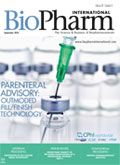Publication
Article
BioPharm International
Implementing a Dual Approach to Protein Characterization
Author(s):
Innovations in electrophoresis and chromatography upstream of protein characterization can accelerate research.
When testing new drug therapies, it is essential to know the identity of the proteins being tested. Whether that protein is the drug itself or the target for the drug, researchers must be absolutely sure of its identity and purity. Though many methods are used in the process of obtaining pure proteins, chromatography is commonly used to separate complex biological mixtures and isolate proteins of interest prior to downstream characterization.
Automating chromatography can help save time and effort in protein purification. But consulting a chromatogram does not always provide adequate confirmation of protein purity. Electrophoresis is often a companion technique to chromatography because it allows researchers an orthogonal method with which to visualize the protein species present in a sample. However, adding this method to a characterization workflow can increase the time to results as the preparation, staining, and imaging steps can be time consuming. Innovations in protein electrophoresis are making this process simpler for lab professionals, with workflows that can be carried out in less than 30 minutes.
Protein purification by chromatography
Recombinant proteins are generally produced in mammalian host cells to ensure that protein therapeutics are correctly folded and have the right posttranslational modifications, such as glycosylation, to ensure they are tolerated by patients. As a result, the therapeutic proteins have to eventually be separated from host cell proteins and other contaminants. One of the most widely used methods for the isolation and purification of recombinant proteins is chromatography (1).
Over the past three decades, chromatography, specifically liquid chromatography, has become the technology of choice in the purification of biotherapeutics, due in large part to its resolving power. Various forms of chromatography, including affinity, ion exchange, and mixed mode, are now being used to ensure that the final product is as pure as can be without compromising yield. New purification schemes are constantly being introduced and optimized to try and find this ideal balance. As these drugs could have significant medical impacts, cost and time are also major parameters to consider when looking for the best purification method.
Newer chromatography systems have been designed with this is mind. Customizable systems that can increase purification capabilities and be adapted to meet growing throughput needs are one example. Another example is integrated software with powerful system controls, including remote monitoring and the ability to automate multistep purifications and carry out complex separation protocols with minimal hands-on involvement.
Despite the versatility and efficacy afforded by chromatography, the technique is not without its drawbacks. One such problem arises from the fact that it is not always possible to determine the purity of a protein just by analyzing a chromatogram. For example, two proteins may elute at similar times, resulting in a single peak on the chromatogram (Figure 1). For this reason, other techniques, such as sodium dodecyl sulfate-polyacrylamide gel electrophoresis (SDS-PAGE), have been combined with chromatography to better elucidate protein purity and yield (2).
Figure 1: Purity assessments are an important part of the protein purification workflow. This chromatogram and sodium dodecyl sulfate-polyacrylamide gel electrophoresis (SDS-PAGE) gel highlight the importance of protein purity assessment throughout a purification workflow. The single peak in the chromatogram is resolved further into multiple bands on the SDS-PAGE gel.

Figure 1: Purity assessments are an important part of the protein purification workflow. This chromatogram and sodium dodecyl sulfate-polyacrylamide gel electrophoresis (SDS-PAGE) gel highlight the importance of protein purity assessment throughout a purification workflow. The single peak in the chromatogram is resolved further into multiple bands on the SDS-PAGE gel.
Gel electrophoresis to determine protein purity
Sample purity is essential to all protein purification workflows and should be assessed at multiple stages of the process. Verifying sample purity throughout the chromatography purification process lets researchers confidently determine the next steps in their workflow as it helps them identify which fractions to pool, which in turn helps them optimize their chromatography runs. SDS-PAGE analysis is a popular method for verifying the purity of proteins during a protein purification workflow because it can be used to easily separate and detect proteins. Various characteristics of the proteins separated by SDS-PAGE can be identified directly on the gels, for example, the multimeric state of the protein through disulfide bonds. In Waki, et al., the authors describe impaired multimerization and/or the consequent impaired secretion of adiponectin to be among the causes of a diabetic phenotype or hypoadiponectinemia in subjects having specific-site mutations (3). Blue-native polyacrylamide gel electrophoresis (BN-PAGE) has been used to isolate protein complexes from mitochondria and for the analysis of protein-protein interactions such as preprotein translocase complexes linked together by their substrates (4). BN-PAGE also provides a high-resolution display of protein subunits, which helps with understanding subunit stoichiometry of protein complexes (5). Downstream of SDS-PAGE and BN-PAGE, protein characterization methods include western blotting (6) and trypsin digestion/mass spectrometric analysis following excision of the protein bands from the gel to confirm their identity. Other downstream analysis examples include structural analysis of the purified protein by circular dichroism (7) or nuclear magnetic resonance (NMR) (8), activity analysis through enzymatic assays using a labeled reporter or substrate, and binding analysis through surface plasmon resonance (9) or enzyme-linked immunosorbent assay (ELISA).
However, SDS-PAGE analysis can be very time consuming. Preparing samples, running the gel, staining and destaining, and imaging can take more than a day. This analysis can add a significant amount of time to a protein purification workflow, especially a multicolumn purification where protein purity is assessed after each column. Due to the highly regulated nature of process-scale protein purifications, it is feasible that standard operating procedures might require purity assessments to be carried out throughout the workflow, which would add to the overall process time and, in turn, increase the costs associated with protein purification. However, in cases where processes are not regulated, researchers sometimes prefer to skip the multiple purity verification steps and instead rely on past purifications and other empirical data to pick the appropriate fractions (10), checking the final purity of their proteins only at the end of the purification process. Given the extremely high stakes in drug development and the need for absolute confidence in protein purity, as well as the need to control costs, researchers cannot afford either to spend a lot of time carrying out purifications or to cut corners. Many efforts have been undertaken to shorten the amount of time it takes to carry out the important validation step provided by SDS-PAGE. They have focused on faster gel running times, quicker acting stains, and even the ability to remove the staining step completely, which reduces assay time even further.
The principle behind stain-free technology is based on the ability of aromatic amino acids such as tryptophan to be modified with ultraviolet (UV) irradiation. This technology has been incorporated into SDS-PAGE gels in which trihalo compounds modify tryptophan residues in the protein sample following UV irradiation. Upon excitation in stain-free enabled imaging systems, the resulting 58 dalton tryptophan adduct emits a fluorescence signal that promotes the visualization of the protein sample (11). Stain-free gels are no different from regular SDS-PAGE gels and can be used with standard buffers and reagents. However, unlike a gel electrophoresis workflow that incorporates a staining step with Coomassie and other dyes, there are no time-consuming staining or destaining steps as the proteins can be visualized directly.
Figure 2: Comparison of stain-free and Coomassie-stained gels. TGX Stain-Free Gels (Bio-Rad Laboratories) were loaded with standards and a serial dilution of a protein mixture with four different proteins with varying tryptophan (Trp) content: phosphorylase B (PB, 1.4% Trp, 97 kD), glutamic dehydrogenase (GD, 0.8% Trp, 56 kD), carbonic anhydrase (CA, 2.3% Trp, 31 kD), and lysozyme (Lys, 3.4% Trp, 14 kD). Gels were run at 300 V for 20 min and immediately imaged using a stain-free enabled imager (A). Gels were then stained with Coomassie stain and imaged using the same imager (B).

Studies comparing the standard Coomassie staining method with stain-free gels have shown that procedures using stain-free gels are significantly faster and substantially improve the SDS-PAGE process. In addition to the significant time savings afforded by the stain-free gels, they offer a lower limit of detection, are more sensitive, and provide a better dynamic range than Coomassie stains (Figure 2) (12, 13). Furthermore, stain-free gels are environmentally safe, as no toxic hazardous organic material is utilized.
Conclusion
As the need for protein therapeutics grows, so too will the need for better and more efficient technologies with which to generate, develop, and manufacture them. Chromatography and gel electrophoresis have long been used in workflows from small-scale discovery through to process-scale protein purification workflows; they provide the versatility and integrity required for drug discovery and development. Reflecting the need to shorten development time, automation of purification methods and stain-free technology have been incorporated into protein purification workflows. The future will bring further refinements of the workflow to speed time to results as the race for drug discovery becomes more competitive. For now, current advancements provide a significant time savings for protein purification workflows, making them an efficient and cost-effective addition to the drug development process.
ALL FIGURES ARE COURTESY OF THE AUTHORS
References
1. C.D. Carr, LCGC 32 (4), 24-29 (2014).
2. D.E. Garfin, Methods Enzymol. 182, 425-441 (1990).
3. H. Waki, et al., J. Biol. Chem. 278 (41), 40,352-40,363 (2013).
4. H. Schagger, Methods Cell Biol. 65, 231-244 (2001).
5. V. Reisinger and L.A. Eichacker, Proteomics. 7 (S1), 6-16 (2007).
6. B. Rivero-Gutierrez et al., Anal. Biochem. 467, 1-3 (2014).
7. W.C. Johnson Jr, Proteins. 7 (3), 205-214 (1990).
8. J. Cavanagh, et al., Protein NMR Spectroscopy: Principles and Practice (Elsevier Academic Press, Burlington, MA, 2nd ed., 2007).
9. R. Karlsson, J. Mol. Recognit. 17 (3), 151-161 (2004).
10. B. Raynal, et al., Microb. Cell Fact. 13, 180 (2014).
11. C.L. Ladner, et al., Anal. Biochem. 326 (1), 13-20 (2004).
12. J.E. Gilda and A.V. Gomes, Anal. Biochem. 440 (2), 186-188 (2013).
13. S.C. Taylor, et al., Mol. Biotechnol. 55 (3), 217-226 (2013).
Article Details
BioPharm International
Vol. 29, No. 9
Pages 34–36
Citation
When referring to this article, please cite it as G. Choudhary and L. Moriarty, "Implementing a Dual Approach to Protein Characterization," BioPharm International 29 (9) 2016.

Newsletter
Stay at the forefront of biopharmaceutical innovation—subscribe to BioPharm International for expert insights on drug development, manufacturing, compliance, and more.




